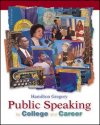 |
1 |  | 
An outline is superior to a script because it lets you see the relationship between ideas. |
|  | A) | True |
|  | B) | False |
 |
 |
2 |  | 
An outline should contain more words than the speech as delivered. |
|  | A) | True |
|  | B) | False |
 |
 |
3 |  | 
In an outline, each heading should have at least two subdivisions or none at all. |
|  | A) | True |
|  | B) | False |
 |
 |
4 |  | 
"An Informative Speech about Tea" is a good title for a speech. |
|  | A) | True |
|  | B) | False |
 |
 |
5 |  | 
In the outline format shown by the text, the introduction and conclusion have their own separate numbering sequence. |
|  | A) | True |
|  | B) | False |
 |
 |
6 |  | 
If you plan to use visual aids, your outline should include a brief description of them. |
|  | A) | True |
|  | B) | False |
 |
 |
7 |  | 
While note cards are acceptable, the very best option is to use no notes at all. |
|  | A) | True |
|  | B) | False |
 |
 |
8 |  | 
When using note cards, you should put your notes on both sides of each card to conserve space. |
|  | A) | True |
|  | B) | False |
 |
 |
9 |  | 
When you give a speech, you should use the same set of notes you used during rehearsals. |
|  | A) | True |
|  | B) | False |
 |
 |
10 |  | 
If note cards are used, they should be numbered. |
|  | A) | True |
|  | B) | False |
 |
 |
11 |  | 
One disadvantage of using a full sheet of paper for notes is that the speaker's eyes might glide over key points because the "map" is so large. |
|  | A) | True |
|  | B) | False |
 |
 |
12 |  | 
In some cases, the text says, you can use visual aids as prompts and therefore have no need for notes on cards. |
|  | A) | True |
|  | B) | False |
 |
 |
13 |  | 
When you are invited to give a speech and no time limit is set, you should feel free to speak for as long as you wish. |
|  | A) | True |
|  | B) | False |
 |
 |
14 |  | 
Once you have created an outline, you should stick with it and not change it. |
|  | A) | True |
|  | B) | False |
 |
 |
15 |  | 
The text advises that you "revise for continuity," which means smoothing out the parts that are disharmonious or clumsy. |
|  | A) | True |
|  | B) | False |
 |



 2002 McGraw-Hill Higher Education
2002 McGraw-Hill Higher Education